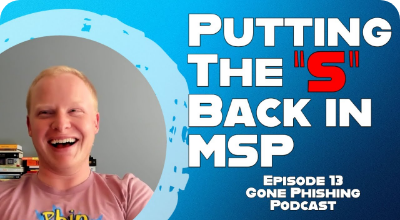


Transcript:
Connor Swalm
Welcome to Gone phishing, a show diving into the cybersecurity threats that surround our highly connected lives. Every human is different. Every person has unique vulnerabilities that expose them to potentially successful social engineering. On this show, we'll discuss human vulnerability and how it relates to unique individuals. I'm Connor Swam, CEO of Fin Security, and welcome to Gone Phishing. Hey, everyone. Welcome back to another episode of Gone Fishing. I'm your host, Connor, CEO at Finn Security, and I am joined once again by Tom Lawrence, CEO and founder of Lawrence Technology and YouTuber extraordinaire, Tom. How are you doing today?
Tom Lawrence
Oh, having fun, man.
Connor Swalm
Having fun. Wonderful. So if you missed the first, this is part two of a three part series on using YouTube to grow your business. What it's all about, how to get started, and how to think about it in general. So if you missed the first part, which is why you should think about getting started on YouTube in the first place, I would highly recommend taking a look at that. Tom was dropping some knowledge on us. He is a very accomplished youtuber. I'll say that, even though you might cringe internally a little bit in front of me, but I'll say it, more subscribers than I will ever have in anything wonderful. So today we're talking about how to get started in YouTube. So how did you get started?
Tom Lawrence
So as we covered some in the last one, I just started throwing some videos up on YouTube because people had asked me. The good news is the getting started is easier now than it was before. Although the market feels more crowded, more people are doing it. Don't just try to be a lifestyle vlogger, please don't. We have a lot of those. You have to be really engaging, compelling, because the people that are doing it right now are very engaging and compelling. And so if you're just doing some lifestyle, or we talked about comedy, probably not. Let's bring it back to what's actionable for probably this audience is going to be. Let's talk about creating tech content, creating things you're passionate about, things you are a subject matter expert in.
So getting started in there, think about those things, especially we mentioned last time, and I'll mention again, it's you ask the answer. That is kind of the answer with YouTube. That book will talk about listening to your clients. What questions are asking the people you engage with, and how do you answer those questions? How do you bring that knowledge to them? You don't just say, hey, I can do this. You can create a, even, there's a big demand for this because people ask me, and I'm just terrible. I'm not good at Azure. There is a YouTube channel out there and they disclose. If I could find the podcast, I'll link it.
They disclosed in a podcast that even though they are only at like the 10,000 or 15,000 subscriber mark, it's bringing them in $30,000 a month in revenue by training people on Azure stuff and how Microsoft office works. They don't even have that many views, there being a thousand views on these videos, but people recognize them as these people are the experts. If I have a problem with my Azure dashboard and how I set up some of these things, or I'm having a trouble integrating active directory things, these are clearly to people called, they have whole tutorials on it that are long videos that are explaining all the intricacies as you know, as a coder. To do this, you look at people, even if you search for coding like Python courses that are 3 hours long with a million views on YouTube.
But there's an audience for that. So start with something you're passionate about. Start getting it out there based on, of course, some of the relevant questions that you want answered, that people ask you.
Connor Swalm
Yeah, you had said something in the previous episode which is along the lines of pretend your client is sitting in front of you asking a question. Whatever that question is, if you like to give that answer, you should make a video on it and put it somewhere for posterity.
Tom Lawrence
Oh, yeah! Giving that answer and just putting it all out there like that, even if it's something that may seem... A lot of this tech stuff seems mundane to us about how we sort an email, but you already know someone's going, oh, sorting email, man, I got this ticket that this client, they keep opening because they think they lost all their emails. They just changed a filter, they're in the wrong inbox. Those are actually very helpful things. And there's going to be someone who says, I don't feel like dealing with the tech guys because they make fun of me every time I submit a ticket for this, they're going to Google, how do I change filters in outlook? And you know that like the back of your hand, do some videos on it.
You'd actually be shocked at how well some of that type of content does.
Connor Swalm
And actually how many people at a help desk probably will just copy a link to that video. And the answer to the ticket is, please watch this. Here's the answer.
Tom Lawrence
I have gotten the weirdest screenshots. One of them does include the fact that hey, time. Want to let you know Verizon is sending your videos out as instructions on how to set up firewalls. Like Verizon corporate was sending it to their end users.
Connor Swalm
Hey, if it's broke, don't fix it. And that sets free publicity for you, isn't it?
Tom Lawrence
Oh, yeah I thought it was great when someone screenshot said, this is our internal corporate mailing. Please do not share. And he's a friend of mine. He tweeted it. They shared on Twitter with me. I'm like, oh, God, that's hysterical. He goes, yeah, Verizon corporate sent me your video when I asked him a question.
Connor Swalm
Commission check is arriving any day now, Tom.
Tom Lawrence
Yeah. I was like, this is wonderful. It made me laugh. But if you think about that, it helps us people, especially the ones that are going, how do I get this ticket solved the fastest? Look, there's a video, and they'll watch a video going, the video is accurate. I don't care who made the video. I don't have to explain this in depth to that user.
Connor Swalm
No, I see that mentality a lot, specifically in my generation as well, is I am more inclined, and everyone that I work with is more inclined to Google a question as opposed to picking up a phone call and asking a person that I know is an expert because I would rather go see the search results, look at all the YouTube videos that show up first and say, all right, this three minute one looks like it's going to help me with my problem. And instead of having to go through click eight if you'd like to talk to a live representative, all right. And then you're going to talk to seven more robots before you get to the got. I buy YouTube premium so I don't have to ever have to watch an ad again and it just starts right away.
Tom Lawrence
I have a relative that's in a remote area, and they broke their phone. I read away. They didn't know how to get the SiM card out. They're like, you said, where it is, but it doesn't make any sense what you said, because they just said, there's a hole, but it doesn't open. They couldn't see the I like, I sent a video with their Motorola phone and how to pop the sim card out and like, oh, my God, that was easy. I'm like, yeah, I don't have that phone. And the first search result on Google was the answer. And I just texted it to her and she's like, oh, thank you. She found it helpful.
Connor Swalm
There's a reason "let me Google that for you" is a very popular website for you or RTFM. Yeah. So other than this Q&A style content, what kinds of content were you thinking about making early on? Or was it even that thoughtful, or was it just oh, that's a cool question. I like this video. Let's do it.
Tom Lawrence
I did leave a lot of these videos up. My channel definitely pivoted. So you want to start with an idea of what you're going to do, but don't fall in love with that idea just too hard because there may be a point where you pivot. And it's kind of interesting because there's even like, unbox therapy is a huge channel with millions of subscribers, and me and him started doing the exact same videos. Did you know he used to have a retail computer store and he used to do retail laptop repair? And his first videos were how to repair laptops. I have those videos. I have a whole bunch of tear down videos of how to fix certain model thinkpads and stuff like that and how to do repairs. That was some of the videos I did in the beginning.
I started with the firewall videos, but then I'm like, well, once you have the big tutorial on firewalls, I don't need to make another one. That one, there's nothing new to add to that. So what else can I do? I don't know. I had a retail computer store, so I have a bunch of laptop repair videos. So a lot of the early stuff is kind of throwing spaghetti at the wall. Do you figure out what's going to stick? Those videos actually got a lot of engagement because I was the first person to post how to do certain screen repairs and how those come apart. Ifixit was just getting started. I didn't have quite the vision to turn into IFixIt. If only I did, I'd be in a different position. But nonetheless, those are different things.
You look for what you're passionate about, what you can put out there. So early videos were first the firewall, then some of the repair videos, and then slowly I started figuring out what the audience was looking for and what I had a passion for. And it aligned to a lot of the enterprise tech that I cover, that I do.
Connor Swalm
So I used to watch unbox therapy to decide what kind of headphones and what kind of screens I would buy from my computer. What did you have for your recording gear early on?
Tom Lawrence
Now, this is where tech nerds are terrible. And there's a whole discussion. As we know, me and you belong to some group slacks, and you will watch the nerds go crazy buying stuff because we have the money to do so. And the answer is always the same. And if you play games, you know the type of gamer I didn't lose because I wasn't good, it's because I didn't have the latest video card. My views on my channel are low because I didn't spend more money on my gear. And people get caught in this loop. There's something about things like, let's bring up Instagram or let's roll backwards. Let's bring up vine. The constraints you have around you, they kind of force you into a creativity niche.
And that's why some of these little platforms that give you constraints are so helpful in the creative process if you constrain yourself to the most basic of equipment. And right now, I am still recording on a probably eight or nine year old yeti microphone. And the reason I'm recording, it still works. It's fine. That was the minimum. Now, for my actual studio, where I'm not doing podcasts, I actually have a nicer senheiser, but I didn't actually buy that until about a year ago, two years ago now, before I went to something higher end, start with the minimal gear. Figure your purpose out first. Figure out what you're going to be doing. And I still have videos that have absolutely incredible number of views that are filmed on a Logitech c 920 webcam. And it's because the content matters more than anything else.
The content, the form, how you present it. Figure out those skills and slowly decide when you find a limitation that you keep hitting going, all right, my audio is bad, definitely. You got to start with good audio if you're in tutorial worlds. But once you get over that, the camera doesn't matter as much. Think about how you present it, how you're articulating it. Focus on those things, and then later buy the gear to augment your storytelling. But if you buy all the gear, you don't know what to do with it, and you'll end up with me sometimes being guilty of this, too. There's a box of things I don't know sure to do with. I've given a lot of it away because I'm like, we can do this bike. I'm like, can you take it? No one really wants to buy these.
You buy a mic for $300. It's completely not the one you should have bought. But you watch this YouTube review on it turns out, yeah, it's not a box.
Connor Swalm
I have this five year old blue Yeti mic that I think was $60 when I bought it. And I don't know if I have a c 920, but I do have a Logitech webcam right here that records in 1080.
Tom Lawrence
Even now, the content we produce for Business Technicalities is done on a... What's that company's name? They make the little movable webcam, Insta 360 webcams! Those are great. Those are amazing. And not only can you start with them, there's still professional game YouTubers and stuff like that are going, wow, this thing is so good, I can use it. Matter of fact, it may be the only camera you need. If you're just doing in studio stuff and it's $300. The cost of getting into YouTube is your time. It's the learning. It's figuring out how to put together your project. It is not gear. This should be. You're doing it wrong if it is. Now, if you're Mr. Beast, that's different. It's all about the production, which also, by the way, most of Mr. Beast is filmed on GoPros, and Mark Rober, once again, he spends over a million dollars per video. And between the iPhone and Gopros, he's admitted that still videos that he has, his last one, I forgot to be a million, but you can tell by looking at, yep, that's a. Yep, that's. That's just an iPhone video. And here he is spending a million on production. By the way, he didn't spend a million on the cameras. He's not shooting IMAX here.
Connor Swalm
Yeah, you know, it'd be a really funny video if Mr. Beast made a video that kind of broke the fourth wall. It's like all of his things start with a statement, "Let's see how expensive of a video we can film with production value or whatever, hires some person to do the production and cut the video and audio up for like a million dollars." I don't know. I feel like it'd be really funny.
Tom Lawrence
Yeah, it would be kind of interesting to do all that. I want to see him shoot with an IMAX camera. Why not? But even his stuff's, like, still a lot of Gopros and stuff like that. And once again, it's not the gear, it's the story. I actually tell people all the time. Casey Neistat's guide to filmmaking is a ten minute video that will change your mind about how things are when it comes to it. And he jokes around that, his first HBO special, and he holds up a camera, a cheap little handicam he's like, we filmed an HBO special with this. And he breaks down why that matters. He's a really good storyteller. He's really strong on how you build the narrative around it. And I see narrative and things like this. If you're telling some biopic, but you're not, you're just creating tutorials.
But if you think on those big scales and bring it down to how you're going to create the tutorial, how you're going to have a good middle and a good ending, those are really important. You hook them in the beginning of telling them what they're going to say. And it's the ending that matters too. Because if you're finding it, you're just putting in filler, you should have ended it already. So you got to have the ending where you wrap it up, you got to have a video that no one wants to stop watching in the middle of. You wouldn't watch a movie that you could turn off in the middle. If you did turn a movie on middle, it wasn't a good movie. You got to have something where you wrap it up and boom. And now you got something complete.
So thinking in those full terms is way more important than any of the gear.
Connor Swalm
I've always gotten two pieces of advice. The first is the production value initially doesn't matter, the quality of the content. And you mentioned something in the last episode we did, which was how much your passion bleeds through into the content matters more. And the second thing that matters most is if you're out of content, if you have nothing left of value to provide, just end the video. End it. Just end the video. Are those accurate? Are both those things accurate?
Tom Lawrence
Yeah, yeah, yeah! People ask why my podcast, which by the way, my podcast, the new one we have, is probably even the top 5% because it's crossed like half a million downloads or more. Even my old one. We ended up in Forrester's on for a Linux podcast, and it made the Forester's top 100 list of podcasts in tech, which I thought was funny. We just talked about Linux, but turns out we're people who are extremely passionate. My co hosts were also like, one of them works for the Linux foundation. He works on a little project you might have heard of called let's encrypt. That's actually one of his babies. But you love watching. This is just a human condition here. We love watching people who are passionate about things, and that makes it kind of fun. And especially when it's tech like cool.
I don't just want to watch a tutorial about tech where it's slowly and methodically explained, but someone who's really put the time in really thought about this. And my favorite comments are hey Tom, you don't tell me just what buttons to click, you tell me why to click them. Because anyone can go third box down, don't check that 1 second box, check this one. Put the number twelve here. It'll work. But I want to explain why it works. And that's where the passion comes in. That way people know, oh, if I adjust this number twelve it can vary these conditions about these settings and that is where I like going a little bit further. But that takes some passion and knowledge to understand and be an expert in it.
You don't have to go this in depth if you're just doing some videos about how to fix things in Outlook, some general customer stuff. I bring up Outlook because I hate outlook, but you could do printer videos on how to fix printers too. Boy wouldn't we rather send a video on how to load the HP drivers and things like that. But those are things you can still bring to the forefront. Put it out there, get some videos that are clear, concise. They don't have to be more than even a minute long. You'd be shocked at how many short videos that I have watched on things that solve problems. Speaking of, I'm wearing a Garmin watch and I was an idiot. Didn't know how a couple of things worked. Turns out there's a couple of videos that were two minutes long and I figured out the stupid problem I was having because it wasn't well explained or intuitive the way they did the UI on this.
Connor Swalm
Yeah, sometimes if the content can be delivered in a very short period of time, that's the best.
Tom Lawrence
Then go for it. It doesn't need to be any longer than it needs to be. If you're just telling someone how to do something simple, then just make that simple video with as many minutes of need and you don't go oh, I didn't meet this five minute, ten minute, 20 minutes, 30 minutes goal of the video. I have hour and a half videos that have incredible number of views. I've got four minute videos that have a lot of views. That's when the content was over. This is all the information I have on this particular topic.
Connor Swalm
Awesome.
Tom Lawrence
It solved the problem. It answered the question that I asked in the title move on.
Connor Swalm
So we have just get started. Doesn't matter what content you create, it has to be that you're passionate about it. And if you're out of content, just end the video. You don't need gear. Just get a laptop with a crappy camera. Get a $60 microphone.
Tom Lawrence
Yeah, the blue Yeti is probably one of my still... Just buy it. It's recommended for starting if you decide this isn't for you. You've only spent $60 on a microphone.
Connor Swalm
And you could still use it for all of your Zoom calls, that you probably do for your job anyway.
Tom Lawrence
So it's definitely great. I mean, don't buy the whole XLR set up. That's expensive. That's a lot more learning of how to ingest all that. This is easy. It's just usb.
Connor Swalm
So that's all of the tactical of how to get started. What would you say to somebody who is having. They are the reason they're not getting started with this. They think they're terrible on camera. They're afraid of public speaking or any variation. It's all in their head. What would you say to them?
Tom Lawrence
One of the ways that I've gotten better at public speaking. When you edit your own videos, there's nothing more punishing than all the just fluences that you have. I still have them, but I'm better and better at not having them, which is because I have to edit them out. So I punish myself by saying them and then having to edit them. The more you edit yourself, the more you think consciously as a feedback loop. So I think that's really good. There's also, I'll just throw out there toastmasters because it's one I've actually been to. There's other places you can go, you can watch other YouTube videos on how to speak better, speaking more concisely, thinking about how you form your words. Those are all things you just build up over time.
So yeah, you're probably, unless you're already a good public speaker, you may not be good at it. And if you are a good public speaker, you may have a problem staring at a camera rather than an audience. Yeah, there's a challenge.
Connor Swalm
There's a challenge either way. For those of you who don't know what Toastmasters is, it's a club that gets together on a consistent basis. There's a bunch of different local ones. There's probably one in your town, wherever you're listening or watching this, and you get together with a group of people who are just trying to get better at public speaking. You play public speaking games to get you engaged in conversation and then also learn tips and tricks on how to not sweat through your clothes. When you're trying to talk in public for real and stuff like that.
Tom Lawrence
Yeah, storytelling and communicating is a huge skill, not just for YouTube, but for your mean. If you're level one help desk, I'm like to learn how to speak better, communicate with management better, convey your message better and being heard will get you further. It works the same way for your real life as it does for YouTube life.
Connor Swalm
Is there any last tip or any last thing that people should think about before getting started?
Tom Lawrence
It's a simple but dumb one. When you start your channel, make sure you start it as a sub channel and not under your username because it turns out even if you're one of the biggest people on YouTube, like MkBHD, that's his actual Gmail address and he just turned it into a YouTube channel. They can't move or convert a channel even at his scale. He's actually talked about that in an interview, that he's 16 plus million subscribers, an insider, so to speak, at YouTube, and he still can't get his change. So when you start it, make sure you say, hey, create new channel. And then have you. You can own the channel with your gmail address, but make sure it's not the same channel that is the default one for your gmail address.
Because once you start, it's I'll kind of out a friend whose stupid email from high school is vanilla Thunder with a bunch of digits after it because of a joke. It's a football joke because he's a big dude and he was really good at football. But it's funny because now everything he does is now tied to that. What his YouTube stuff that he did for a while was all tied to that, which I thought was funny. So definitely make sure you start it with whatever name. It also allows opportunities later for you to have co creators. That's harder to do if you own it under your same Gmail name. It's an easy but simple mistake because you're like, oh, there's the upload button, but if it's under a name, you can't change that later. You can't move the views.
You can re upload the videos to a new channel you create, but those subscribers and viewers don't come with it.
Connor Swalm
Yeah, and there'd be a lot of attrition.
Tom Lawrence
Yeah, it's a weird challenge, but it's one of those people overlook it and you don't want to get too far down the rabbit hole before you do that.
Connor Swalm
Yeah. So just get started, folks. Don't worry about the gear. Be super passionate and make sure you click the create new channel, don't create it under your so.
Tom Lawrence
Absolutely.
Connor Swalm
That's the how tos from Tom Lawrence. Once again, I'm your host, Connor, CEO at Phin Security. And this was part two of a three part series. We're about to do the next one as well on how to get started with YouTube and how to think about it to use it for growing your business.
Tom Lawrence
Thank you. Sweet.
Connor Swalm
See y'all in the next one. Thanks so much for tuning in to Gone Phishing. If you want to find out more about high quality security awareness training campaigns, how to launch them in ways that actually engage employees to change their habits, then check us out. Phin Security at Phinsec.io. That's P-H-I-N-S-E-C IO. Or click all of the wonderful links in our show notes. Thanks for fishing with me today, and we'll see you next time.






